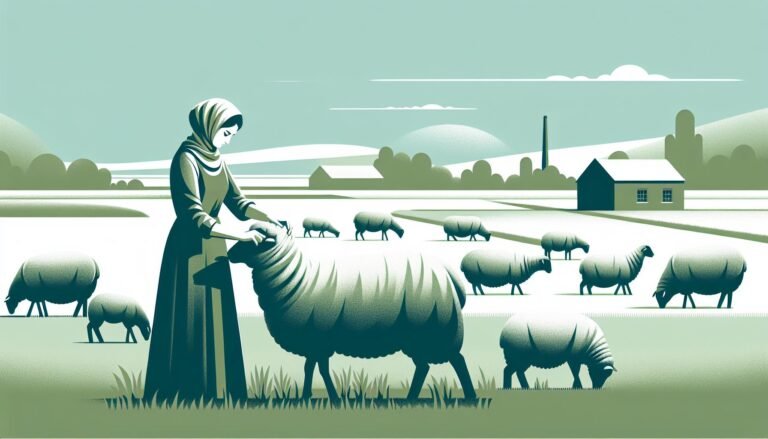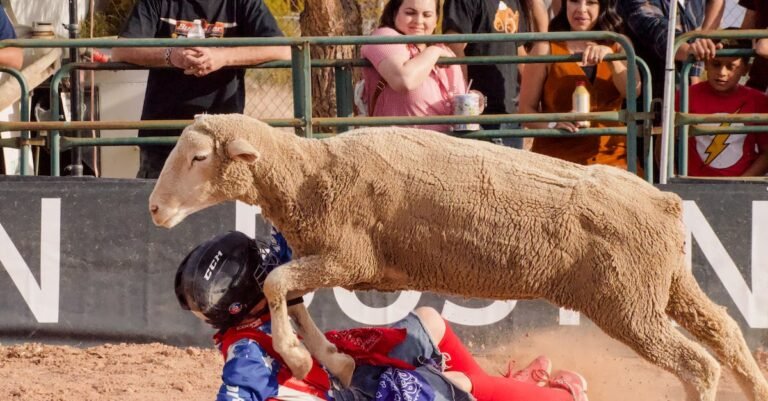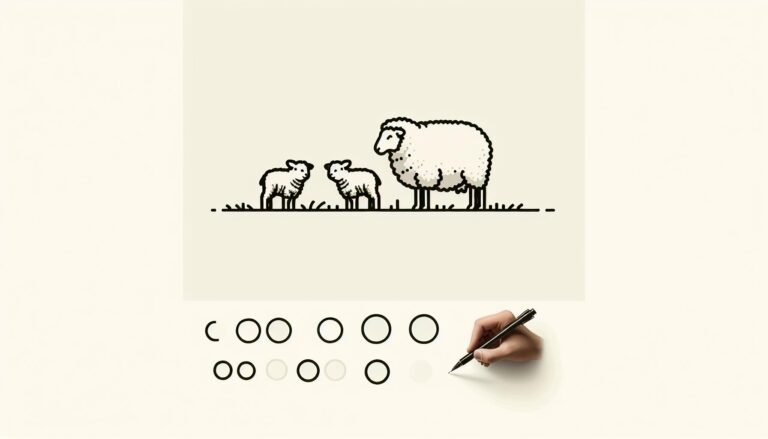Unveiling the Truth: Do Sheep Destroy Grass or Promote Ecosystem Diversity?
Ever wondered if sheep are lawn mowers in disguise? It’s a question that’s crossed my mind as I’ve watched these fluffy creatures graze. After all, they seem to have an insatiable appetite for green pastures.
But do sheep really destroy grass? Or are they nature’s way of maintaining a healthy lawn? It’s a topic that’s sparked much debate among farmers and environmentalists alike.
In this article, I’ll delve into the impact of sheep on grasslands. We’ll explore whether these woolly grazers are friends or foes to our green spaces. Stay tuned for a deep dive into the world of sheep and grass.
Key Takeaways
- Sheep are selective grazers, meaning they control the types of plants in their environment and promote plant diversity.
- They can, however, also cause harm to ecosystems by overgrazing certain plant species, potentially leading to its extinction.
- The sheep’s hooves play a significant role in soil health, as they till and aerate the soil as they graze, promoting seed germination and plant growth.
- High sheep density can lead to soil compaction, hindering plant growth and potentially causing runoff and erosion.
- Proper grazing management is crucial in maintaining the health of ecosystems and preserving plant diversity.
- Apart from grazing, sheep also enhance soil health through their manure, which is rich in nutrients, creating a self-sustaining cycle of growth and grazing.
The Grazing Habits of Sheep
It’s important to understand the difference between sheep and other grass eaters when discussing the influence of sheep on grasslands. Unlike cows and horses, sheep are selective grazers. What does this mean? Simply put, sheep don’t just munch on every green they come across. They prefer certain types of grass and herbs and will thoroughly graze these areas.
Grasslands are home to a plethora of plant species, and sheep play a role in maintaining this diversity. Thanks to their selective grazing habits, less dominant plant species often get a chance to flourish. This leads to a more vibrant ecosystem, richer in biodiversity.
Nevertheless, it’s not all rainbows and butterflies. Selective grazing can also lead to some issues. Sheep have been known to overgraze their preferred plant species, sometimes to the point of extinction. This can disrupt the balance of the ecosystem and lead to a reduction in biodiversity.
One more critical aspect to consider is the relationship between sheep and soil. As they graze, sheep’s hooves till the soil. This action can potentially promote seed germination and plant growth. However, it can also lead to soil compaction if the sheep population density is too high, creating problems for plant growth.
Here’s a quick rundown of the key points discussed:
- Sheep are selective grazers. Unlike many other grazers, they show a preference for certain plants.
- Selective grazing can promote plant diversity, yet can also lead to overgrazing and loss of certain plant species.
- Finally, sheep can affect soil health both positively and negatively. Their hooves can help till the soil but may also lead to soil compaction in high sheep density areas.
As we continue to explore the effects of sheep on the environment, we’ll dive into more details about each of these aspects. Each contributes in its own unique way to shaping the landscape.
The Effects of Sheep Grazing on Grasslands
When discussing the effects of sheep grazing on grasslands, plant diversity is always at the forefront. When left to graze naturally, sheep prefer certain types of grass and herbs, selectively nipping off the tops. This selective feeding behavior can promote plant diversity, leading to a more vibrant ecosystem. Yet, there’s a flip side to this coin.
When sheep populations become too dense on a single plot of land, they are notorious for overgrazing particular plant species, throwing the ecosystem off balance and reducing biodiversity. Sheep, being the survivors they are, will consume available resources to their limit. Under these circumstances, grasslands may shift from a diverse mix of plants to a more uniform composition, often dominated by the species that are less desirable to sheep.
A second key aspect relates to the physical impact of sheep grazing. Sheep’s hooves may till the soil, helping to disperse seeds and promote their germination. It can stimulate plant growth, particularly aiding plants that thrive with light surface disturbance.
However, a large number of sheep in one area can tip the balance. High sheep density may lead to soil compaction, which hampers plant growth and can result in runoff and erosion.
Like any grazing animal, sheep’s impact on grasslands can be either positive or negative, depending largely on how they are managed.
Sheep grazing impacts on grasslands:
| Benefit | Detriment |
|---|---|
| Promotes plant diversity | Relocates seeds |
| Stimulates plant growth | Can cause soil compaction |
| Mechanically tills the topsoil | May lead to overgrazing in denser populations |
These aspects make it clear that grazing management is incredibly crucial for balancing the desires and needs of agricultural production with ecosystem health. The focus must always be on sustainable practices to ensure we are benefiting the land, rather than harming it. Sustainable sheep grazing practices make an essential contribution to environmental stewardship.
Sheep as Natural Lawn Mowers
In the diverse world of grazing, sheep have their unique place. Often compared to lawnmowers, they’re incredible tools for maintaining lawns and pastures due to their selective grazing habits.
Sheep choose their meals very selectively. They typically prefer forbs, short plants with flowers, and legumes, a group of plants which include peas and beans, over grasses. In doing so, they naturally promote plant diversity. It’s like having a natural landscaping crew without the heavy equipment! They create a balance, allowing different types of plants to flourish.
You might ask, “What if the sheep eat too much?” When managed properly, overgrazing is rarely an issue. Just as you wouldn’t let a lawnmower run indefinitely, same goes for these fluffy lawnmowers. Ensuring that your sheep don’t overgraze requires careful attention to grazing patterns and adjustment of herd size as needed.
One interesting point about sheep is their contribution to soil health. The physical impact of a sheep’s hooves can serve to till the soil, promoting seed germination and plant growth. However, a high sheep density on the pasture can lead to soil compaction, which is why grazing management becomes crucial to maintaining a healthy balance in the field.
Moreover, this duality of promoting growth and potentially causing damage to the soil creates an interesting dynamic within the ecosystem. Sheep naturally fertilize the soil with their manure, giving the soil valuable nutrients for plant growth, creating a self-sustaining cycle of growth and grazing.
So next time you see a flock of sheep, you might not just see a source of wool and mutton. They’re sources of biodiversity and contribute to vibrant ecosystems! From a simple lawn to vast grasslands, sheep play an important role, one that requires careful attention to detail and management. But let’s delve deeper into soil health as it plays a critical role in maintaining vibrant pastures.
Ecological Benefits of Sheep Grazing
Diving deeper into our discussion of sheep and their impact on grasslands, let’s shed light on the ecological benefits these wooly grazers bring to the table.
First off, comparing sheep to nature’s very own lawnmowers isn’t off the mark. They’re selective eaters and favor certain types of plants over others. Rather than mindlessly munching away at every blade of grass in sight, sheep promote plant diversity. By favoring some species and leaving others to thrive, they create a mosaic pattern of growth. This diversity helps support a wider range of insect and bird species, adding another layer to the grazing cycle.
Now let’s discuss the physical impact of sheep on the terrain. When sheep move over the land, their hooves act like a natural tiller. They break up the soil surface, making it more receptive to rain and less prone to run-off. This increase in soil permeability enhances the germination of seeds and the growth of diverse plant species, contributing to a more vibrant ecosystem.
Managing the size of the herd is vital. While a well-sized herd can promote healthy soil and plant diversity, overgrazing can lead to the compaction and degradation of the soil. It’s all about finding the right balance: Grazing patterns and herd size should be monitored carefully to prevent overgrazing.
But it’s more than just what sheep eat or tread on that makes a difference. Sheep also contribute to soil health through their manure. Loaded with organic matter and essential nutrients, this natural fertilizer creates a self-sustaining cycle of growth and grazing.
Balancing the needs of the land with the grazing habits of the sheep requires thoughtful stewardship. Sheep don’t just manage the land; they transform it, thanks to their dietary preferences and physical activity. They aren’t just grazers; they’re crucial partners in preserving and enhancing the health and diversity of our grasslands.
Conclusion
So, do sheep destroy grass? Not at all. In fact, they’re nature’s little landscapers. Their selective grazing habits encourage plant diversity, while their hooves work like a natural tiller, improving the soil and promoting growth. They also contribute to the health of the ecosystem, supporting a range of insect and bird species. But it’s not all about letting them loose. Proper management is key to prevent overgrazing. Balancing herd size and grazing patterns is crucial. And let’s not forget, their manure is a natural fertilizer, enhancing soil health. It’s a self-sustaining cycle of growth and grazing. Sheep don’t just eat grass – they nurture it, shape it, and help it thrive. With careful attention and management, sheep can play a vital role in maintaining vibrant grasslands.







